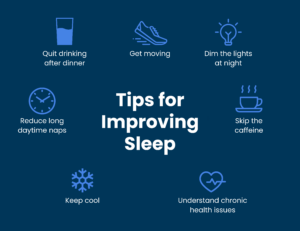Children develop food preferences early, so try to expose them to as many varieties of food as possible. It could take several exposures before they take an interest in trying a new dish.
Limit sugary drinks at mealtimes in favor of milk and water (which are less damaging to teeth). Protein from beans, edamame, nuts, seeds and soy products provides essential nutrition without the calories found in meat products.
Keep it Nutritious
Kids often mimic their parent’s eating habits and behaviors, so setting an example by offering nutritious snacks and meals, and dining together whenever possible is important for children’s development. Discourage eating in front of the TV or computer screens as this may encourage mindless snacking habits.
At mealtimes, strive to include foods from each food group in your meal plans. Select items low in fat, saturated fat and sodium (salt). Examples of healthy options for each food group would include whole grain bread and pasta products, fruits and vegetables, dairy and soy products, lean meats poultry fish eggs. Also ensure each meal and snack includes protein-rich seafood bean pulses soy products nuts unsalted seeds as source.
Encourage your child to try new foods by making the experience enjoyable. Remember that it may take multiple attempts for kids to accept new food items; don’t give up! Additionally, introduce them alongside familiar favorites – adding broccoli florets as soup topping or as pizza topping may work wonders!
Make healthy beverages part of your child’s regular diet, and avoid soda and high-calorie snacks like chips. Children can learn portion control by stopping eating when their stomach is full – avoid the “clean plate club” and teach your children to listen to their body for hunger and satiety signals.
Snack Smart
Children tend to eat what’s readily accessible, making nutritious options accessible and easily available essential. Avoid high-fat and high-sodium options (cookies, snack bars, chips, candy and soft drinks), while being mindful of portion sizes when creating snacks that match up with their age and activity level.
Serve a variety of fruits, vegetables, grains and proteins at meals and as snacks throughout the day, such as lean meats, eggs and fish as protein sources. Moderate your fat consumption; find options lower in saturated and trans fat such as olive oil, avocados, nuts or seeds to provide healthy fat sources in moderation.
Prepare ahead by spending just a few minutes each day cutting fruit and vegetables, creating dishes like yogurt bark, roasted chickpeas or banana bread, as well as keeping water, low-fat or fat-free milk and fortified soy beverages on hand in the fridge so your children have access to healthy snacking in between meals.
Be an example and show your children by not eating in front of or using TV as a distraction during mealtimes, helping them focus on eating and listening to their hunger cues. Designate a snack area in your home so as to prevent mindless munching!
Don’t Forget the Fats
Finding ways to get kids excited about nutritious food can be challenging as they grow, says dietitian Diana Schnee. However, developing good eating habits early will ensure they remain healthy into adulthood.
Assure your kids eat healthfully by offering fresh, frozen, canned vegetables; whole grains; low-fat or nonfat dairy products; lean protein sources like poultry, fish, nuts and beans. When choosing healthy snacks for children it’s best to steer away from sugary drinks and foods which contain many extra calories such as fruit juice.
Healthy fats are essential to children’s development. They help fill them up faster, improve concentration levels, and can boost mood. Make sure your child has access to both monounsaturated (like olive oil and avocado) and polyunsaturated fats from nuts (including peanuts), seeds and vegetable oils for optimum performance.
Serve an array of side dishes instead of only fries, chips and rice at dinner time. Also avoid using dessert as an incentive for eating vegetables or other healthful foods – this could send the message that these treats are less desirable.
Kids must learn to listen to their bodies when it comes to hunger and fullness, for instance by not encouraging them to finish everything on their plate when hungry; this could lead to overeating later. When feeling full, children should also be allowed to stop eating; though this may be difficult at first for those raised under a “clean-plate club”, but will help them learn self regulation of intake in the long run.
Be Active
Children need physical activity in order to learn, grow and stay healthy. Parents, caregivers, and teachers can assist children with developing healthy lifestyle habits by encouraging good eating practices, restricting screen time usage and encouraging physical activity.
Mealtimes can be an opportunity for children and families to come together, bond, and build healthy eating skills. Setting an example by eating nutritious foods together and without distractions (TV or video games) can set an excellent example for your kids. Children have an instinctive urge to imitate adults so be sure they see you enjoying a variety of fruits, vegetables, whole grains, lean proteins while limiting sugary beverages, salty snacks or saturated fats as part of a balanced diet.
Make meal and snack times routines. Plan to have meals and snacks at similar times each day in order to prevent overeating and ensure an appropriate, satisfying diet. Serve child-sized portions; this may increase children’s willingness to try new foods (for instance presenting broccoli florets as trees or yellow squash as the sun). Get them involved in grocery shopping and meal preparation; this gives them a sense of independence while increasing the chance they’ll try what you prepare!
Remind yourself that, at this age, it’s normal for kids to occasionally crave French fries or pizza; what matters more is what they eat over time.




